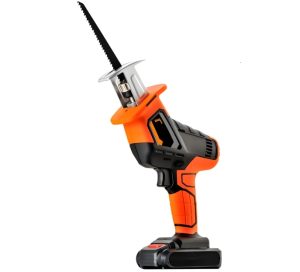Our Location
304 North Cardinal St.
Dorchester Center, MA 02124

Reciprocating saws, also known as “Sawzalls” (a trademark of Milwaukee Tool), are essential tools for a wide range of cutting tasks in construction, demolition, and remodeling. When choosing a reciprocating saw, one of the primary decisions is whether to go with a corded or cordless model. Both types have distinct advantages and disadvantages, and the choice ultimately depends on the specific needs and preferences of the user. In this detailed analysis, we will explore the key differences between corded and cordless reciprocating saws, examining factors such as power, convenience, versatility, and cost.
Corded Reciprocating Saws:
Corded reciprocating saws are known for their consistent and high power output. Since they are plugged into an electrical outlet, they can draw continuous power, which translates to superior cutting performance. This makes corded saws particularly suitable for heavy-duty tasks such as cutting through thick metal, hardwood, or concrete. They typically have higher amperage motors, often ranging from 10 to 15 amps, which provide the torque needed for demanding applications.
One of the major advantages of corded saws is that they do not suffer from power drop-off. Users can operate them for extended periods without worrying about battery life. This makes them ideal for professional contractors and tradespeople who need reliable performance throughout the workday.
Cordless Reciprocating Saws:
Cordless reciprocating saws, on the other hand, offer the convenience of portability and freedom from power outlets. They are powered by rechargeable batteries, usually lithium-ion, which provide a decent amount of power for most cutting tasks. The voltage of these batteries typically ranges from 18V to 60V, with higher voltage models offering better performance.
While modern cordless saws have made significant strides in terms of power and efficiency, they still generally fall short of the raw power that corded saws can deliver. However, advancements in battery technology have led to longer runtimes and faster charging times, mitigating some of the traditional drawbacks of cordless tools. For many users, especially DIY enthusiasts and those working on smaller projects, the power provided by cordless saws is more than sufficient.
Corded Reciprocating Saws:
The primary limitation of corded saws is their dependence on a power outlet. This can restrict mobility and make them less convenient for outdoor use or in areas without easy access to electricity. The cord can also be a hindrance, potentially getting in the way during operation or posing a tripping hazard.
However, for tasks performed in a workshop or on a construction site with ample power sources, the inconvenience of the cord is often outweighed by the consistent power supply.
Cordless Reciprocating Saws:
Cordless reciprocating saws excel in terms of convenience and portability. The absence of a power cord allows users to move freely around the job site, making them ideal for cutting tasks in tight spaces, on ladders, or in remote locations. This flexibility can significantly improve productivity and ease of use, especially for tasks that require frequent repositioning.
The downside is that cordless saws rely on battery life, which can limit continuous operation time. Users must manage battery charging and may need to invest in multiple batteries to ensure they have enough power for extended work sessions. Despite this, the trade-off is often worth it for the enhanced mobility and ease of use.
Corded Reciprocating Saws:
Corded saws are highly versatile in terms of the range of materials they can handle due to their consistent power output. They are well-suited for heavy-duty applications such as demolition work, cutting through masonry, and thick metal pipes. The robust performance makes them a go-to choice for professionals who need to tackle a variety of challenging tasks.
Cordless Reciprocating Saws:
Cordless saws offer versatility in terms of where they can be used. Their portability makes them perfect for tasks that require frequent movement and for use in areas without power access. They are suitable for a wide range of materials, though they may struggle with extremely tough or thick materials compared to their corded counterparts. For light to medium-duty tasks, cordless saws are highly capable and versatile.
Corded Reciprocating Saws:
Corded saws are generally less expensive upfront than their cordless counterparts. The absence of batteries and chargers reduces the initial cost. Additionally, users do not need to factor in the ongoing expense of replacing batteries over time. For those who require a high-performance tool for frequent and demanding use, corded saws often provide the best value in terms of cost and longevity.
Cordless Reciprocating Saws:
Cordless saws typically have a higher initial cost due to the inclusion of batteries and chargers. However, the cost can be justified by the added convenience and portability. For users who prioritize mobility and ease of use, the investment in a cordless saw can be worthwhile. Moreover, the overall value can be enhanced if the user already owns other cordless tools that use the same battery platform, allowing for battery sharing and reducing the need for multiple chargers.

When choosing between corded and cordless reciprocating saws, several user-specific factors should be considered:
The choice between corded and cordless reciprocating saws hinges on balancing the need for power and performance against the desire for convenience and portability. Corded reciprocating saws remain the go-to option for heavy-duty applications and situations where consistent power is crucial. Their lower initial cost and reliable performance make them a favorite among professionals.
Cordless reciprocating saws, however, have revolutionized the way many tasks are approached, offering unparalleled mobility and ease of use. Advances in battery technology continue to narrow the performance gap between corded and cordless models, making cordless saws increasingly viable for a broader range of applications.
Ultimately, the decision should be based on the specific requirements of the tasks at hand, the work environment, budget considerations, and personal preferences. Both corded and cordless reciprocating saws have their place in the toolkit of modern craftsmen and DIY enthusiasts alike, each offering distinct benefits that cater to different needs.